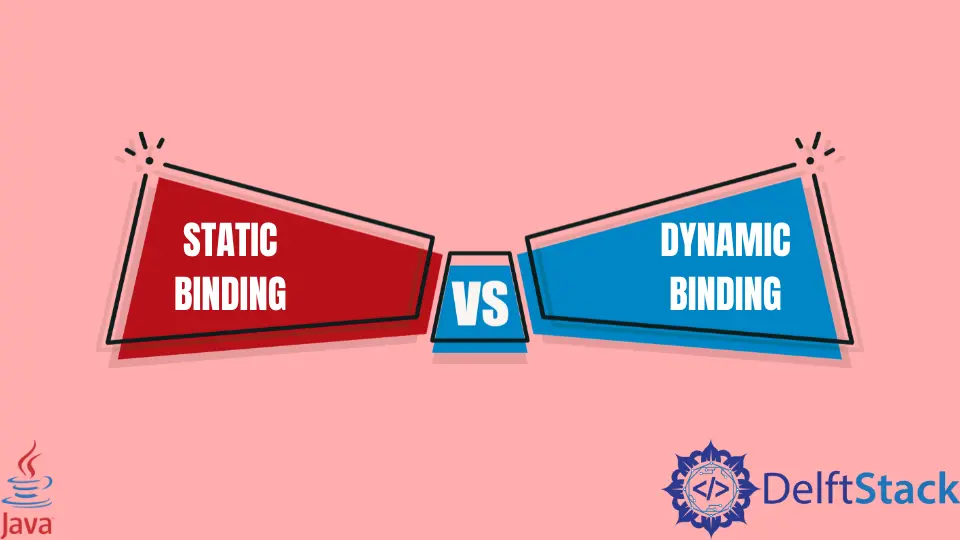Java 中静态绑定和动态绑定的区别

本教程介绍了 Java 中静态绑定和动态绑定之间的区别,并列出了一些示例代码以指导你了解该主题。
绑定是将方法调用链接到方法实现,它有两种类型:静态和动态。根据多态性,一个对象可以有多种形式,这些形式可以在编译时或运行时解析。
当方法调用在编译时链接到方法实现时,就会发生静态绑定。动态绑定在运行时发生时发生。让我们详细了解这两种类型的绑定并查看一些示例。
Java 中的静态绑定
如上所述,静态绑定是在编译期间发生的绑定。它也被称为早期绑定,因为它发生在编译时本身。
在静态绑定的情况下,编译器确切地知道要使用该方法的哪个实现。它使用类型或类信息进行绑定;方法重载是静态绑定的一个例子。
请注意,所有静态、最终和私有方法都使用静态绑定,因为子类不能覆盖静态、最终和私有方法。编译器在编译时就知道要使用哪个方法实现。由于编译器知道父类的方法不能被覆盖,所以它总是使用该方法的父类实现。
此外,静态绑定的性能也更好,因为涉及的开销更少。
Java 中的静态绑定示例
在下面的代码中,学校类有一个静态的 ringBell() 方法,这个类是由 Classroom 扩展的。Classroom 也有一个 ringBell() 方法。
由于 ringBell() 方法是静态的,编译器只检查类类型,不考虑分配的对象类。因此,当使用 School 类创建 Classroom(School s2 = new Classroom()) 的对象时,将考虑 School 类的实现,而不是 Classroom 类。
class School {
public static void ringBell() {
System.out.println("Ringing the school bell...");
}
}
class Classroom extends School {
public static void ringBell() {
System.out.println("Ringing the classroom bell...");
}
}
public class Main {
public static void main(String[] args) {
School s1 = new School(); // Type is School
s1.ringBell();
Classroom c1 = new Classroom(); // Type is Classroom
c1.ringBell();
School s2 = new Classroom(); // Type is School
s2.ringBell();
}
}
输出:
Ringing the school bell...
Ringing the classroom bell...
Ringing the school bell...
Java 中的动态绑定
动态绑定在运行时解析绑定,因为编译器不知道在编译时使用哪个实现。
它也被称为后期绑定,因为绑定是在运行时的后期而不是在编译时解析的。动态绑定也使用对象而不是类型或类进行绑定;方法覆盖是动态绑定的一个例子。
Java 中的动态绑定示例
在下面的代码中,ringBell() 方法不是静态的,因此会发生覆盖。编译器不知道应该使用 ringBell() 方法的哪个实现,因此绑定是在运行时解析的。
在运行时,会考虑对象而不是用于创建它的类型。因此,当使用 School 类创建 Classroom 的对象时,将考虑 Classroom 类的实现,而不是 School 类。
class School {
public void ringBell() {
System.out.println("Ringing the school bell...");
}
}
class Classroom extends School {
@Override
public void ringBell() {
System.out.println("Ringing the classroom bell...");
}
}
public class Main {
public static void main(String[] args) {
School s1 = new School(); // Type is School and object is of School
s1.ringBell();
Classroom c1 = new Classroom(); // Type is Classroom and object is of Classroom
c1.ringBell();
School s2 = new Classroom(); // Type is School and object is of Classroom
s2.ringBell();
}
}
输出:
Ringing the school bell...
Ringing the classroom bell...
Ringing the classroom bell...
Java 中的静态绑定和动态绑定
静态绑定是在编译时方法调用与方法实现的连接。另一方面,动态绑定是方法调用在运行时与方法实现的连接。
了解这两种技术对于理解多态性的概念很重要。静态绑定被静态、最终和私有方法使用;这种绑定在方法重载的情况下生效。动态绑定用于虚拟方法(在 Java 中默认为虚拟)并用于绑定被覆盖的方法。